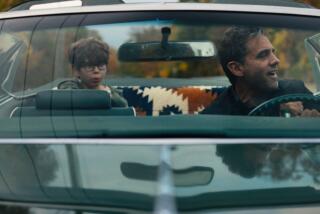A Sleuth Captures His Goldwyn : Biographer Scott Berg masters the clues in tracing the life of movie mogul
The conscientious biographer of a departed figure is like a private eye--Ross Macdonaldâs Lew Archer comes to mind--trying to follow a very cold trail into the past, in the hope of finding clues to all that happened later.
The public years of the man who named himself Sam Goldwyn were abundantly documented. Hollywoodâs most successful independent producer (âDodsworth,â âWuthering Heights,â âThe Little Foxes,â âThe Best Years of Our Livesâ and many other films in a 40-year career) had decided as early as 1949 that he wanted a biography written, but not in his lifetime. After his death, at the age of 94 on Jan. 31, 1974, a succession of secretaries had put every scrap of his papers into chronological, alphabetical order, down to and including Frances Goldwynâs grocery orders to Jurgensenâs.
Goldwynâs early years, which probably began in Warsaw, Poland, in July, 1879, were another matter, as Scott Berg discovered. Bergâs massively detailed 580-page biography, âGoldwynâ (Knopf, $24.95), being published officially tomorrow, required a detectiveâs combination of persistence, persuasiveness, imagination and sheer good luck.
âHe spent years covering his tracks,â Berg says in his book. âStarting at an early age, Samuel Goldwyn invented himself.â He was born Schmuel Gelbfisz in Warsaw, although not, as he later claimed, on Aug. 27, 1882.
âI found a London address from the 1940s for a first cousin of Samâs from Warsaw,â Berg said a few days ago. Berg wrote the cousin a letter and waited--waited two years in fact while the letter was forwarded from London to Shanghai and other addresses and finally to New York, where the cousin was by then living.
The cousin had known Goldwynâs sturdy and strong-faced mother, Hannah, and supplied details about the familyâs life in Poland. Berg also read books on the Warsaw of the period and studied maps of the city in the New York Public Libraryâs collection. He was also able to locate other family members, among them a few nieces, including the daughter of Goldwynâs sister.
It is still not quite certain how or precisely when Goldwyn came to the United States. Berg spent three days in the Public Records Office in London, pouring over the passenger lists of every ship that sailed to North America about the time Goldwyn swore he had entered the United States. (âI thought he might well have been truthful about that.â)
âI finally found a Sam Goldberg,â Berg says. âHe fit the description, the age, even the town heâd come from. I have no doubt itâs our Sam.â
What is amazing is that, leaving home in 1895 at the age of 16 to make his fortune, Goldwyn walked 500 miles from Warsaw to Hamburg, Germany, where he learned a bit about glove making before he went on to London. He hiked another 120 miles to Birmingham, where prospects proved dim.
âGoldwyn always liked to walk,â Berg says. âHe, and sometimes he and his wife, Frances, walked from their house on Laurel Way in Beverly Hills to the Goldwyn Studio on Formosa.â The limousine trailed discreetly behind. âThe police used to stop and question him occasionally. You donât walk in Beverly Hills.â
If Berg is correct, Goldwyn sailed to Canada in steerage from Liverpool in November, 1898. He stayed briefly in New York and settled in Gloversville, N.Y., in the Mohawk Valley, which had indeed become a glove-making center.
He was now Sam Goldfish. The name Goldwyn he invented later, when he was living in New York and starting in show business, partnered with Edgar Selwyn.
Berg spent two weeks in Gloversville studying the city directories, which were the phone books of their day, and reading the bound volumes of a glove-makers journal, which he discovered was charting the rise of Sam Goldfish, a glove maker turned ace glove salesman turned factory owner.
âSuddenly here were mentions of a firm called Goldfish & Sesonske,â says Berg. âThere were still some Sesonskes in the Gloversville phone book. Thatâs not an everyday name and sure enough they were children and grandchildren of the Sesonske whom Sam was in business with.â
âThe trail widened as the years went on, but at first there was almost nothing.â Even so, Bergâs researches into the European origins were his second priority.
âI knew I was running a race with mortality,â Berg says, âso as soon as I began the project, I made a list of the people I needed to see and graded them in order of age and frailty.â When a seer predicted that Lucille Ball, a Goldwyn discovery who had appeared in âRoman Scandals,â would not last out the year, Berg prudently jumped her up on the list, although luckily the seerâs crystal ball turned out to be clouded. Eventually he did 250 interviews. Four of his primary sources--William Wyler, King Vidor, Lillian Hellman and George Cukor--did not live to see the completed book, nor did several of his other sources, from Mary Astor to Danny Kaye and Rabbi Edgar Magnin.
Only Irving Berlin would not see him.
âKatharine Hepburn and Irene Mayer Selznick became my two godmothers on the project,â Berg says. âIrene (the daughter of Louis B. Mayer) says she is cursed with an incredible memory. I asked her about Nick Schenck and she described the blue suit and the tie he was wearing the first time her father brought him home.
âI asked her about the first house Sam and Frances Goldwyn had at Camino Palmero and Hollywood Boulevard and she described it in such detail I was sure she must be making it up. But when I saw photographs, and then the house itself, I realized she had it all right, even to the number of steps up from the street. She gave me wonderful takes on people.â
Hepburn volunteered to intercede for Berg with Irving Berlin and walked over to his Beekman Hill house on Manhattanâs East Side to leave a note. Berlin, now nearing 101, appeared on the stairs (this was three or four years ago), invited her in and they chatted for two hours.
âShe stopped by the next day to leave some flowers as a thank you. Berlin appeared again and they talked for another two hours. But he still wouldnât see me, Kate told me, a little smugly, I thought,â Berg adds with a grin.
After the critical and commercial success of Bergâs first book, a biography of Max Perkins--who had been the editor of Fitzgerald, Thomas Wolfe, Hemingway and other important 20th-Century literary figures--Sam Goldwyn Jr. approached Berg about the possibility of doing the biography of Sam Sr.
âWe had our first discussion late in 1978 and we negotiated through much of 1979,â Berg says. Their agreement, finally concluded in January, 1980, was that Berg would have unlimited access to the voluminous Goldwyn archives--then locked in a warehouse--and total freedom to quote from them at will, and that Sam Jr. and the family would exercise no control whatever over the book Berg wrote.
Sam Jr. also sat for 60 hours of taped interviews. âHe spoke with unbelievable candor,â Berg says. âItâs what puts the book across. His life was no picnic. I also spoke to Goldwynâs daughter Ruth, Sam Jr.âs half-sister who for years he didnât even know existed. For years his father never told him about her. She became a key reason I wanted to do the book.â
Mrs. Goldwyn finally effected a reconciliation between her husband and Ruth, the child of his first marriage. Before that, his rejection of Ruth was Dickensian, or Freudian in its cruelty. His attitudes toward Sam Jr. alternated between short-lived sweetness, stony indifference and a hectoring demand that he outperform the world. The parental Goldwyn is not a pleasant study.
Berg spent two years doing his interviews, then another two years doing the research, the reading and the on-the-ground investigations. He took six months to organize his materials, grouping his 5-by-7 file cards into folders. âSo âWuthering Heightsâ would have several folders, including one on James Roosevelt, whom Sam hired for about a year in that period.â
Writing the first draft took a year and a half, and it came to 2,400 manuscript pages. He needed another year and a half to condense it to manageable size.
Berg concluded that perhaps half the famous Goldwynism (âInclude me outâ) were genuine, the rest concocted by his busy publicists or simply ascribed to him because they sounded like him. Sam paid publicist Ben Sonnenberg $50,000 to tone up his image, then decided he was probably better off being colorful.
And the items of Goldwyn-speak that Berg includes are funny enough. Sam always called it âThe Three Little Foxesâ and he once said that âHello, Dolly!â was the dirtiest picture heâd ever seen. Someone noted that it wasnât even out yet and did Goldwyn mean âValley of the Dollsâ? âThatâs what I just said,â Goldwyn said, â âValley of the Hello Dollies.â â He described one crisis as like being âon the brink of an abscess.â
In some ways, Berg says, there were similarities between Goldwyn and Max Perkins. âEach was a hub of a larger artistic wheel. Each was a catalyst, a harnesser of talent. But there, I think, the similarities end.
âWith Perkins I had a time finding enough material; with Goldwyn there was almost too much. There was so much material, but there were so many lies, whereas with Perkins there was always a clean slate. With Perkins you went to the Dictionary of American Biography and all his people were there.â
The biographerâs perils include faulty memories and outright lies. Lillian Hellman, Berg is convinced, told him some absolute fibs, insisting she had told Goldwyn she wouldnât work on âThe Goldwyn Folliesâ when Berg had the documents that indicated she did. He tactfully tells it both ways.
Both men, says Berg, were very good company, which is lucky since Perkins preempted seven years of Bergâs life and Goldwyn nine. âThere was a lot I couldnât stand about Goldwyn, but there was a lot that was interesting, and he did have humor. He had great energy and to see him at 80 with the enthusiasm of 30 was fascinating.
âThere was that, and his survival mechanism. He couldnât be knocked down in any way, but people tried. He was a risk-taker and he was always out on a limb by himself. No stockholders. He could always say, âMy mistakes were my own,â and to be able to say that is something. In the end, I admire the life-journey of the man.â
The life of Goldwynâs second wife, Frances, was also hard to put together, says Berg. âShe was the classic child of alcoholics. The more I learned about alcoholism, the more I learned about her.â Despite her husbandâs great success, she lived with insecurity. Afraid they would lose their house, she once went unannounced to Pickfair and prostrated herself before Mary Pickford, begging Pickford to settle a long-standing financial quarrel with Goldwyn.
In Goldwynâs lifetime, Frances was one of the townâs preeminent hostesses. After he died, Berg says, the orders to Jurgensenâs changed from filet mignon and fresh vegetables to butt steak and frozen peas and Frances became increasingly reclusive.
Bergâs key source on Frances was George Cukor, for whom she worked as a young actress in New York and Rochester and with whom she enjoyed a platonic romance the rest of her life. She asked Cukor if she should marry Goldwyn and Cukor said, âItâs the best part youâll ever get.â
She was jealous of Hepburn, another woman in Cukorâs life. Frances arranged for Cukor to be buried with Goldwyn and herself and her mother in a crypt at Forest Lawn in Glendale, as he is. Making the arrangements, Frances said, âAt least Kate wonât get him there.â
The biography is not toned with the evident loving admiration Berg felt for Perkins. It is rather more an exhaustive case history of an engrossingly difficult man whose contributions to the worldâs popular culture also demand admiration, however grudging.
Now Berg is pondering a short list of candidates for his next biography. Who, he has to ask himself, is worth another five to 10 years of his life?
More to Read
Sign up for our Book Club newsletter
Get the latest news, events and more from the Los Angeles Times Book Club, and help us get L.A. reading and talking.
You may occasionally receive promotional content from the Los Angeles Times.








